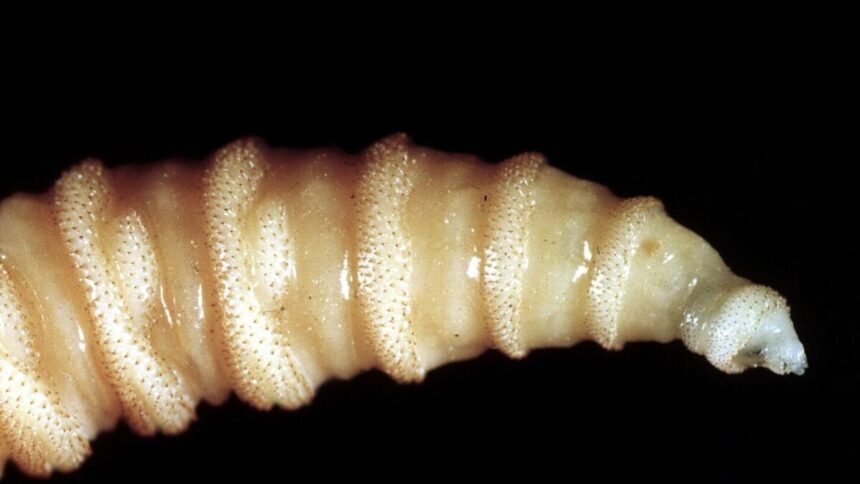The U.S. The Department of Agriculture has declared war on a flesh-eating maggot that infests wildlife, livestock, household pets, and, in rare cases, people. The battle strategy? Dumping billions of sterilized flies out of planes over Mexico and Texas.
Using this tried-and-true biological control technique, the USDA aims to stamp out the larvae of the New World screwworm (NWS) fly, a tropical parasite. This invasive pest’s scientific name is Cochliomyia hominivorax, which literally means “man-eater.” The flies target warm-blooded animals, laying eggs near open wounds and mucous membranes, according to the Texas Farm Bureau. When the eggs hatch, the maggots burrow deep into the host’s living tissue, eating it as they grow and causing painful, potentially deadly wounds. If the NWS fly spreads throughout the U.S., it could decimate the livestock industry, kill wild animals in droves, and pose a significant risk to pet and human health.
“A thousand-pound bovine can be dead from this in two weeks,” Michael Bailey, president-elect of the American Veterinary Medicine Association, told the Associated Press.
To eliminate this pest, USDA scientists are breeding adult male NWS flies and sterilizing them with radiation before releasing them from aircraft. When these flies mate with females, the eggs they produce won’t hatch, thus reducing the number of maggots and causing the population to die out over time. This approach is more environmentally friendly than pesticides, and while it may sound counterintuitive, it has worked in the past.
“The United States has defeated NWS before and we will do it again,” USDA Secretary Brooke Rollins said. From 1962 to 1974, the U.S. and Mexico released more than 94 billion sterile flies to eradicate the pest, according to the USDA. By 2000, the pest was contained below Panama thanks to a sterile fly facility there, though small outbreaks continued to occur in the U.S. occasionally, like the one that struck the Florida Keys in 2017.
“It’s an exceptionally good technology,” Edwin Burgess, an assistant professor at the University of Florida who studies parasites in livestock, told the Associated Press. “It’s an all-time great in terms of translating science to solve some kind of large problem.”
Over the past several years, NWS fly populations south of the U.S. have expanded northward, according to the American Farm Bureau. Recent detections in Mexico as far north as Oaxaca and Veracruz—just 700 miles (1,127 kilometers) from the southern border—prompted U.S. officials to suspend cattle, horse, and bison imports through the border on May 11.
On June 18, Rollins announced the development of an $8.5 million sterile NWS fly dispersal facility alongside an aggressive plan to prevent this pest from re-entering the U.S. The fly factory, located at Moore Air Base in south Texas, should be complete by the end of the year. It could boost domestic sterile fly production by up to 300 million flies per week, complementing current facilities already operating in Panama and Mexico. The USDA has also invested $21 million toward renovating an existing fly factory in Metapa, Mexico, which will provide an additional 60 to 100 million sterile NWS flies per week to stop the spread. On top of Panama’s production, this will release at least 160 million flies in Mexico and Panama per week, the USDA states.
The first weeks of this NWS fly attack strategy have already shown results. Since officials closed southern ports to livestock in May, the USDA has dispersed more than 100 million sterile NWS flies per week in Mexico, according to a statement released Monday, June 30. The agency said it has not seen a notable increase in parasitic NWS infections in Mexico or any northward movement of this pest over the past eight weeks. Based on these findings, the USDA has decided to gradually reopen select southern border ports to livestock trade beginning July 7.
These are good signs that officials are regaining control of this pest. As the planet continues to warm, however, more invasive insects and parasites will creep northward from the tropics, threatening U.S. agriculture, biodiversity, and public health. As such, sterile fly breeding and distribution programs may become increasingly necessary. Burgess argues that officials should keep fly factories open even after they have neutralized the threat of NWS. “Something we think we have complete control over—and we have declared a triumph and victory over—can always rear its ugly head again,” he said.
Read the full article here












